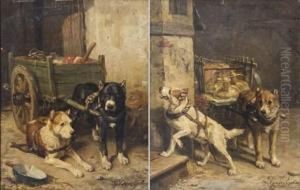Charles Van Den Eychen Paintings
Charles Van Den Eychen was a Belgian painter born in 1859 in Antwerp, a city known for its rich artistic heritage. His artistic journey began in his hometown, where he was deeply influenced by the vibrant art scene of the late 19th century. Van Den Eychen is primarily remembered for his contributions to landscape painting, a genre that he approached with a unique blend of realism and impressionism. His work captures the beauty of the Belgian countryside, characterized by its lush landscapes, serene waterways, and quaint rural villages. Throughout his career, Van Den Eychen remained dedicated to exploring the interplay of light and color, striving to convey the atmospheric conditions of his chosen scenes with a remarkable sense of authenticity and emotional depth.
Van Den Eychen received his formal art education at the Royal Academy of Fine Arts in Antwerp, an institution renowned for fostering the talents of many distinguished artists. Under the tutelage of accomplished painters, he honed his skills and developed a keen eye for detail, which became a hallmark of his work. Despite the prominence of academic training in his early years, Van Den Eychen was also influenced by the emerging Impressionist movement, which encouraged him to experiment with looser brushwork and a brighter palette. This blend of traditional and modern techniques allowed him to create works that were both timeless and contemporary.
Throughout his career, Van Den Eychen exhibited his work widely, gaining recognition both in Belgium and abroad. His paintings were well-received by critics and collectors alike, earning him a respectable place among his contemporaries. Despite his success, he never strayed far from his roots, often choosing to depict the landscapes and scenes of his homeland. Charles Van Den Eychen passed away in 1923, leaving behind a legacy of work that continues to captivate and inspire. His paintings can be found in various museums and private collections, serving as a testament to his enduring appeal and contribution to the world of art.
